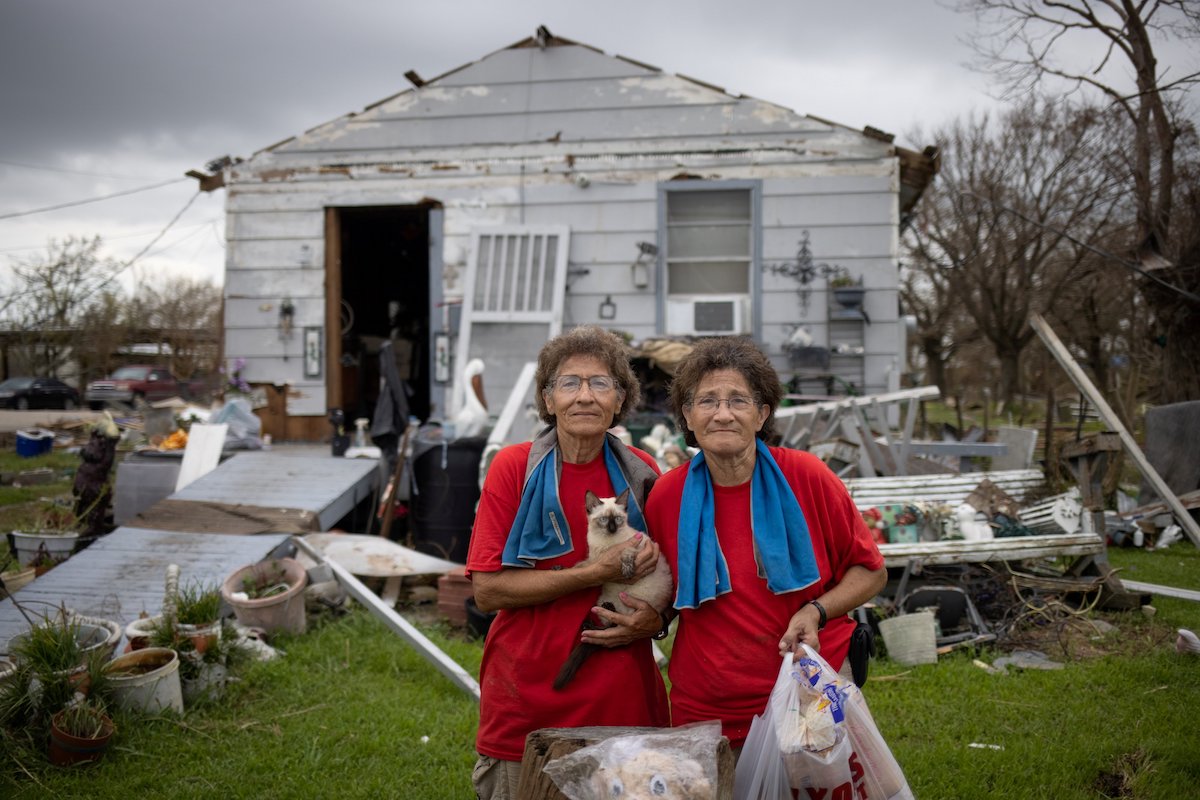A scattering of Hurricane Ida evacuees from storm-battered Louisiana to neighboring states across the south is presenting a familiar crisis for regional Catholic Charities agencies following Hurricane Ida’s Aug. 29 landfall.
“Our experience here is similar to that of Hurricane Katrina in that the real need is coming from the damaged infrastructure and failed power lines and so we have evacuees coming here and coming to the shelters,” said David Aguillard, executive director of Catholic Charities of the Diocese of Baton Rouge, Louisiana.
Aguillard spoke to Catholic News Service by phone Sept. 1, four days after Ida slammed into Southeastern Louisiana as a high Category 4 hurricane with its 150-mph winds and heavy rains.
The storm then knocked out power, water and cellphone service and even emergency medical care throughout greater New Orleans and Houma-Thibodaux areas in particular. It is recorded as one of the strongest landfalling hurricanes on record in Louisiana.
As a result, untold numbers of hurricane evacuees left for Texas, Mississippi, along with Arkansas, Alabama, Florida and even points as far north as Chicago, according to Aguillard.
Many discovered that hotels along the Gulf Coast were full and so some had to return to sweltering Louisiana and its ongoing power outages because they lacked better options.
“I know evacuees are going mostly to Texas and Mississippi and those Catholic Charities are doing what they can but those areas are not opening shelters and so they are coming back because this is where the shelters are,” Aguillard added.
Ida arrived on the 16th anniversary of Hurricane Katrina, which inundated 200,000 homes in New Orleans due to the failure of several flood-protection levees.
The 2021 storm is being described partly in terms of its catastrophic effect on the region’s power infrastructure, which in turn creates problems for water, sewage, gasoline supply and communications.
As with Katrina, Catholic Charities in nearby Baton Rouge may play a repeat role as a regional disaster relief staging area and communications center serving hard-hit New Orleans and Houma-Thibodaux.
Following Katrina, the Catholic Charities staff in New Orleans temporarily moved their operations and personnel to Baton Rouge.
Hurricane Ida passed along the eastern edge of greater Baton Rouge, leaving a greater swath of destruction on the western part of New Orleans.
Still, Baton Rouge was not completely spared. A number of Catholic Charities staff from the Baton Rouge Diocese have been left scrambling for housing and much of the area is without electricity while lines for gasoline are several hours long. Cellphone communications to the hard-hit areas remains spotty.
“That is impacting our ability to get out to the communities and the church parishes to do assessments and bring supplies,” Aguillard said. “We are a little short staffed, due to the employees who were impacted. What we are doing now is gearing up for the long haul, to get mobilized and organized.”
The big needs now are tarps for shelter and cash to purchase whatever is most needed in given communities.
“Some communities might need food and another community might need diapers, so cash is the most needed resource following a disaster. It takes the government weeks to get mobilized,” he added.
Aguillard participated in a regional conference call Sept. 1, which Catholic Charities USA convened as it prepared to dispatch resources, emergency response and personnel to the area.
Charities staff and case workers from Baton Rouge are already working in local area shelters run by Red Cross and state and local governments.
“The best thing is to help people move out of the shelters and move in with family members, which is safer, so we try to help them travel to move to more suitable housing in the meantime,” Aguillard said.
In Tallahassee, Florida, Gabe Tischler, emergency management specialist for the Florida Conference of Catholic Bishops, was also on the Catholic Charities conference call where dioceses in Louisiana and the Gulf Coast from Texas to Florida were reporting power outages, an influx of evacuees and gasoline and water shortages.
Tischler said that Lake Charles, Louisiana and Biloxi, Mississippi were identified as two areas that had warehouse space available to serve as regional staging and distribution centers. Catholic Charities of Northwest Florida, he added, has already provided some gift cards and transportation vouchers to evacuees in Florida.
“Houston has a very large number of evacuees, Florida has some, and north through Arkansas, which is pretty common,” Tischler said.
Days after the storm, Louisiana Governor, John Bel Edwards, told Hurricane Ida evacuees that it’s too soon to return while more than 1 million homes and businesses in that state and in Mississippi remain without power. It is believed that Texas received the majority of Louisiana and Mississippi evacuees after Hurricane Katrina.
Between flooding, wind damage and power outages, housing is going to be an issue for the next six to eight months following Ida, Tischler said.
“They will get New Orleans up and running (with electricity) as soon as possible, but my guess is it will take several months longer in outlying areas.”
He praised the quick work of the Federal Emergency Management Agency in getting financial assistance underway to newly displaced families in Louisiana.
FEMA generally provides upwards of $35,000 in grants to individual households who lost their home in a hurricane or flood but don’t have insurance.
At this time, he said donations of goods and clothing are discouraged as they incur high costs from shipping and transportation. He also discouraged “self-deployment” of well-meaning individuals or parishes thinking of driving into the New Orleans area now to help out.
“I can’t stress this enough that the best way to help is to donate to Hurricane Ida Relief directly to Catholic Charities in your diocese or in other states,” Tischler said.
Catholic Charities USA is accepting donations to help the hurricane relief efforts at catholiccharitiesusa.org.







